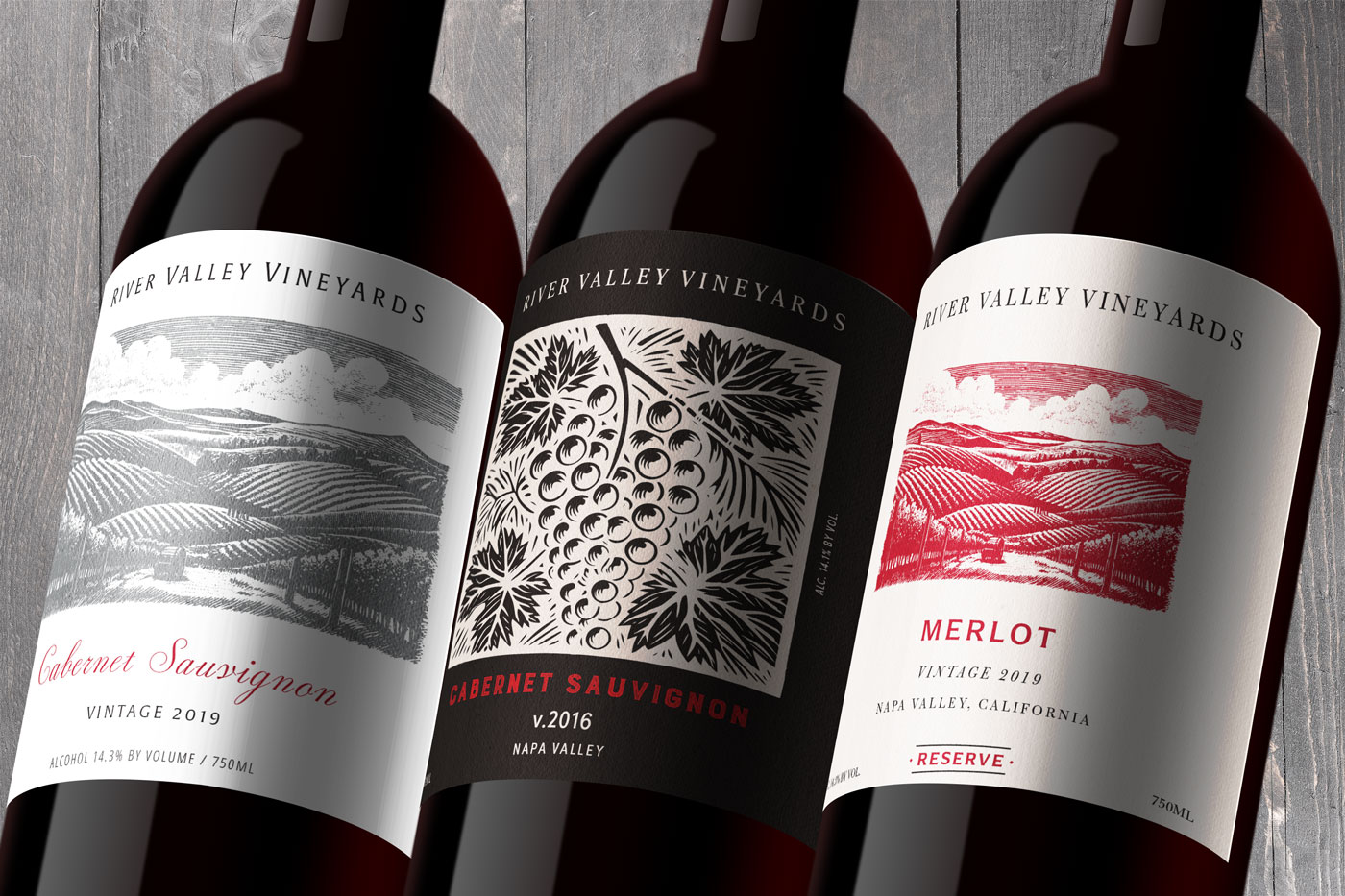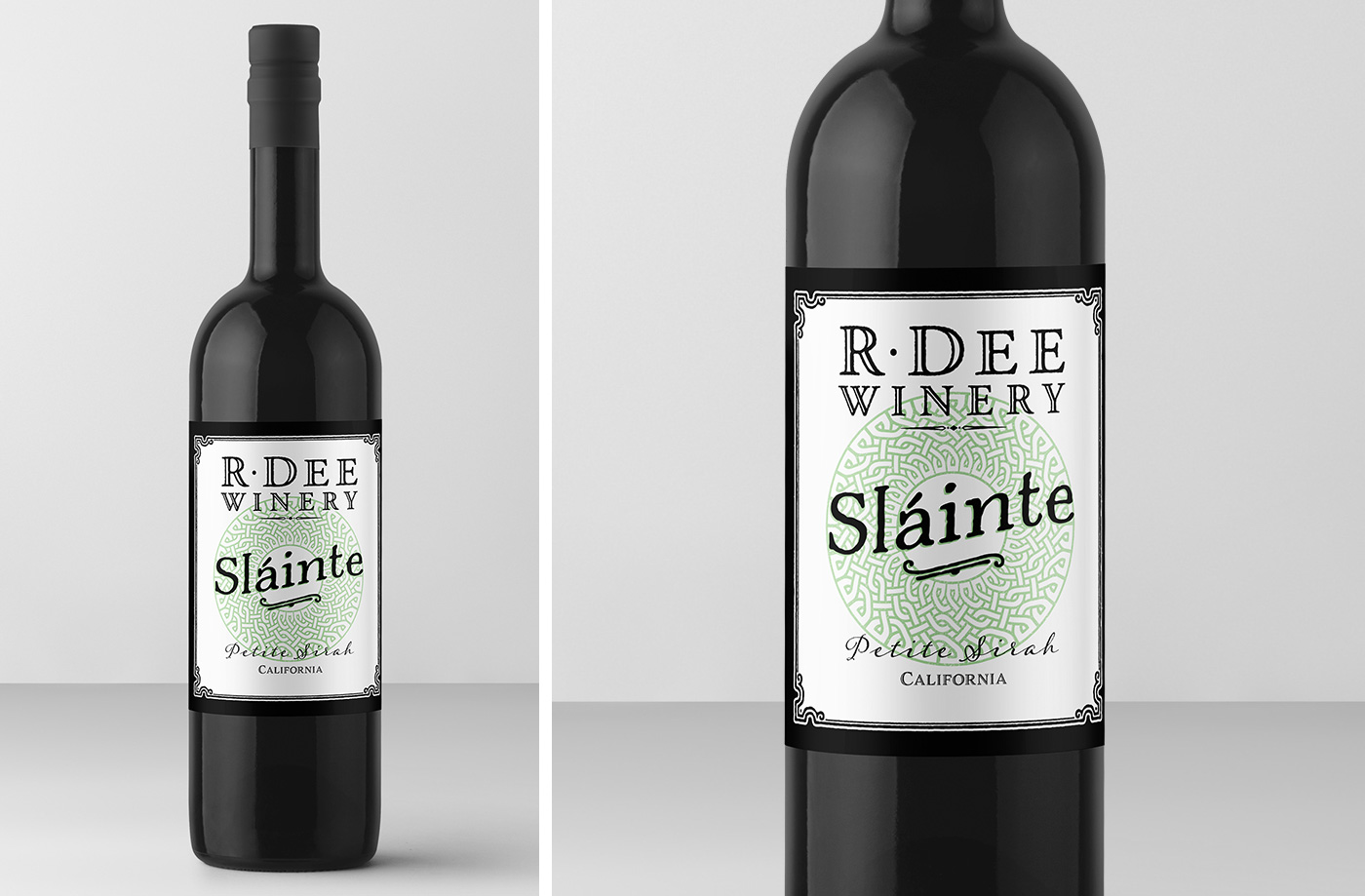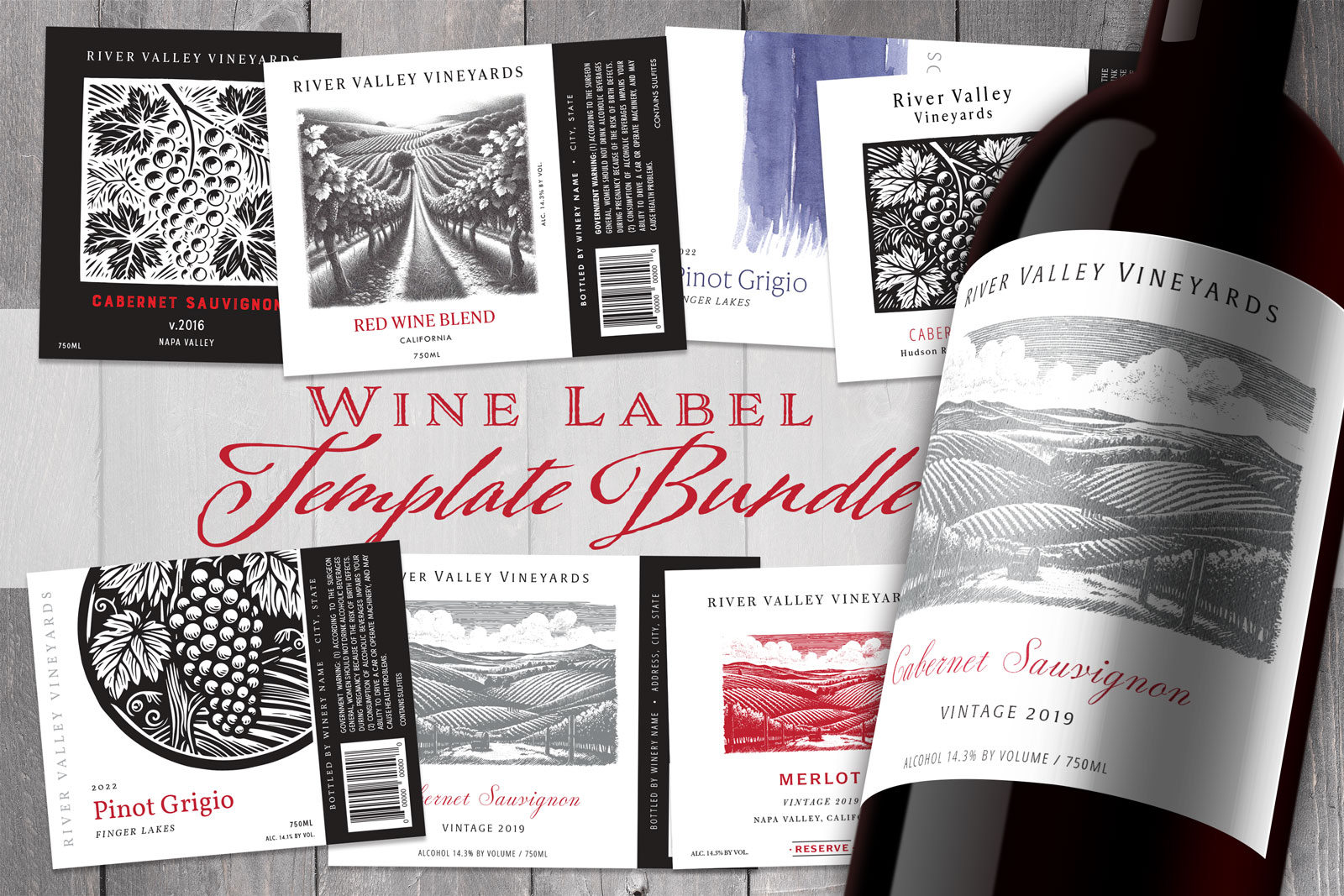Craft Beverage Blog
TTB Wine Label Design Requirements: Everything You Should Know
“In wine, there’s truth” – but there’s also a trove of regulations that wine producers must adhere to when crafting the label on their bottles. While many wine enthusiasts focus on the varietal, there’s a whole world of information conveyed through the label. The Tobacco and Alcohol Tax and Trade Bureau (TTB) has established these wine label requirements to safeguard consumers and provide essential information.
What is the Wine Brand Label?
Typically, the brand label is the front-facing label on a wine bottle – however it does not need to be (see fig. 1). If multiple labels are used, the TTB requires one label to be designated a Brand Label to obtain a Certificate of Label Approval (COLA). The brand label is the one that showcases the unique design and carries the wine’s brand name. According to TTB regulations, specific details must be present on this label of a wine container. While there’s a set of required information, other essential details and extra information can also find a place on any label. It’s a bit like a wine’s signature look – distinctive, but with room for more details beyond the must-haves.
Brand Label Requirements
- Brand name
- Class or type designation
- Appellation of origin (see exceptions below)
- Alcohol content
- Net contents
- Name and address
- Health warning statement
- Sulfite declaration (if applicable)
- Disclosure of certain ingredients (if applicable)

Brand Name: The Identity of the Wine
The brand name on a wine bottle is more than just a fancy typeface; it’s a requirement. Typically, the brand name signifies the producer, winery, or vineyard. Think of iconic brand names like Caymus, Decoy, Barefoot, Josh Cellars, and Meiomi.

Bottler’s Name and Address
The name and address requirements on a wine label are crucial elements that provide transparency about the wine’s origin. For American wine, the label typically includes the name of the bottler or packer and their location details (city and state) as indicated on the basic permit. This statement is introduced by the relevant phrase, either “Bottled by” or “Packed by.”
Optional terms, such as “Produced by” or “Vinted by,” can be incorporated if desired, providing additional clarification about the specific activity conducted at that particular location.
Type/Class/Varietal Designation: Unraveling Wine Types
The Type/Class/Varietal Designation on a wine label plays a crucial role in categorizing and communicating the nature of the wine. It signifies whether the wine is table wine, dessert wine, sparkling wine, or another specific type. TTB regulations stipulate that certain classes of wine, such as Table Wine, Dessert Wine, or Fortified Wine, must be appropriately designated.
Additionally, if the wine qualifies for an appellation of origin, this designation is required to appear in direct conjunction with the class and type designation. A grape varietal is considered the class/type designation if it is present on the brand label. For a wine that lists the grape variety, the appellation of origin is also required. For example:
Merlot
Napa Valley
This example indicates a minimum of 75 percent of the wine is sourced from Merlot grapes cultivated within the Napa Valley region of California.
Common Designations
- Table Wine
- Dessert Wine
- Red Wine
- Rose Wine
- White Wine
- Cabernet Sauvignon
- Merlot
- Chardonnay
- Pinot Noir
- Sauvignon Blanc
- Syrah or Shiraz
- Zinfandel
- Riesling
- Malbec
- Grenache
- Tempranillo
- Sangiovese
- Nebbiolo
- Cabernet Franc
- Petite Sirah
- Viognier
- Pinot Grigio
- Gewürztraminer
- Chenin Blanc
Appellation of Origin
An appellation of origin is not required on all wine labels. However, the label must include an appellation of origin if the wine is labeled with:
- A vintage date;
- A varietal designation;
- A type designation of varietal significance;
- A semi-generic designation;
- An “estate bottled” claim; or
- A product name qualified with the word “brand” under the requirements of 27 CFR 4.39(j).
According to TTB, when an appellation of origin is required to appear on the label, it must appear on the Brand Label.
- Labeling with a Specific Viticultural Area (AVA): If the wine comes from a specific American Viticultural Area (AVA), that AVA must be listed on the label. List of Established American Viticultural Areas (AVAs)
- State or County Designation: If the label includes a state or county designation, the grapes used to produce the wine must be primarily from that state or county.
- Multi-State Blends: If the wine is a blend of wines from multiple states, the label must include a multi-state designation.
- Generic Designations: Wines labeled with generic terms like “American,” “United States,” or a state name must contain grapes from at least 75% of that region.
- Foreign Wine with an AVA: If a foreign wine claims an AVA, at least 75% of the grapes used to make the wine must be grown within that AVA.
| Scenario | Appellation of Origin Requirement |
|---|---|
| Wine from a specific AVA | AVA must be listed on the label. |
| State or county designation on the label | Grapes must be primarily from that state or county. |
| Multi-state blends | Must include a multi-state designation. |
| Generic designations | Grapes from at least 75% of that region. |
| Foreign wine with an AVA | At least 75% of grapes must be grown within that AVA. |
ABV Requirement: Understanding Alcohol Content
Every bottle of wine must provide information about its alcohol content, referred to as Alcohol by Volume (ABV). The use of “proof” is not allowed on wine labels. U.S. regulations permit a 1.5% variation in ABV. The classes of wine, such as Table Wine and Dessert Wine, are differentiated by their alcohol content. Table Wine falls within the range of 7%-14% ABV, while Dessert Wine contains 14%-24% ABV. In this context, the words “Table Wine” and “Dessert Wine” don’t need to be explicitly mentioned on the label, which is why you may not have seen them at your local store.
The words may appear in capital letters or lower case letters. Abbreviations may also be used.
ALCOHOL (ALC.) ___ % BY VOLUME (VOL.)
___ % ALCOHOL (ALC) BY VOLUME (VOL)
Vintage Date: A Timeless Clue
The vintage date is essential for wine enthusiasts. It indicates the year the grapes were harvested, and it’s critical for understanding when a wine is at its best. Vintage wines often have specific qualities and characteristics that vary from year to year. It is often used for still wines (non-sparkling) and is particularly important for wines that are made from a single grape variety or from grapes harvested from a specific vineyard.
- Single Vintage Wines: Wines made from grapes harvested in a specific year are often labeled with that vintage. This is common for high-quality wines, especially those from renowned vineyards or wineries.
- Fine Wines: Premium or fine wines often emphasize the importance of the vintage year. Certain years may be considered exceptional due to favorable weather conditions, resulting in higher quality grapes and wines.
- Vineyard Designation: Some wines are labeled with the name of a specific vineyard, and the vintage date is crucial in these cases. It helps consumers understand the uniqueness of the wine produced from grapes grown in that particular year at that specific vineyard.
- Appellation Requirements: In some wine regions, appellation regulations may stipulate the use of vintage dates for certain types of wines. For example, wines labeled with a specific geographical indication may be required to display the vintage.
Yes, if wine is vintage dated, an appellation of origin is required. The appellation must appear in direct conjunction with the class and type designation.

Net Contents/Volume Requirement
In the world of wine labels, size does matter. The net volume of contents must be indicated in milliliters (ml) on the label to ensure that customers know exactly how much wine they’re purchasing.
Sulfite Declaration: Protecting Wine and Consumers
During the winemaking process, yeast transforms grape sugars into ethanol. Sulfites are sometimes added to protect the wine from oxidation and microbial contamination. Since some individuals have sensitivities to sulfites, if the sulfating agent concentration is 10 ppm or higher, a declaration like “Contains Sulfites” or “Contains a Sulfating Agent(s)” must be included on the label.
Health Warning Statement: A Sober Reminder
The following statement is required to be on all alcohol beverages containing 0.5% or more alcohol by volume:
GOVERNMENT WARNING: (1) ACCORDING TO THE SURGEON GENERAL, WOMEN SHOULD NOT DRINK ALCOHOLIC BEVERAGES DURING PREGNANCY BECAUSE OF THE RISK OF BIRTH DEFECTS. (2) CONSUMPTION OF ALCOHOLIC BEVERAGES IMPAIRS YOUR ABILITY TO DRIVE A CAR OR OPERATE MACHINERY, AND MAY CAUSE HEALTH PROBLEMS.

Design and Font Specifications
The TTB has strict guidelines for fonts and type on wine labels to ensure clarity:
- Must be easily legible under ordinary conditions.
- Must appear on a contrasting background.
- Must be separate from or significantly more conspicuous than descriptive or explanatory information.
Optional Label Considerations
Detailed Descriptions
Incorporating informative descriptions about your wine, winery, and winemaking process is invaluable for conveying the distinctiveness of your product to consumers.
Website Link and QR Codes
Integrating digital content links, such as a website URL and QR codes, provides an avenue for offering additional valuable information to your customers and can significantly contribute to your marketing initiatives. However, it’s essential to adhere to TTB’s advertising regulations regarding the content linked to web addresses.
Barcodes
Including barcodes on your wine label not only enhances traceability throughout the supply chain but also plays a pivotal role in preventing errors, minimizing manual data entry, and optimizing overall operational efficiency. Moreover, many retailers stipulate the inclusion of barcodes as a prerequisite for considering the inclusion of your product in their inventory.
Fanciful Name
A fanciful name, distinct from the brand name, is a descriptive phrase employed to further identify a product. This element can contribute to creating a unique identity for your wine, separate from the winery name or varietal designation, thereby adding an extra layer of individuality to your brand. Understanding these requirements is crucial for both wine producers and consumers. The details on a wine label go beyond aesthetics; they provide essential information about the wine’s origin, composition, and potential health considerations.
For a comprehensive list of wine label requirements, visit the TTB’s official page: TTB Labeling Wine Requirements.








